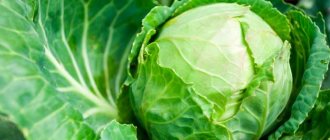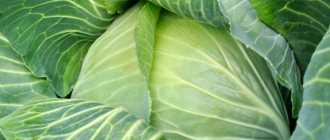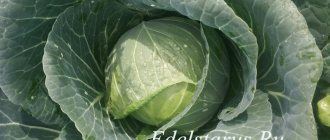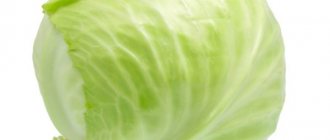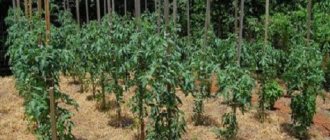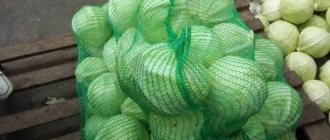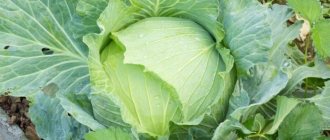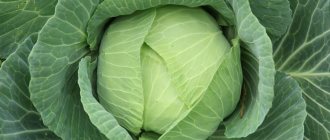White cabbage Zenon F1 is a hybrid whose flesh is denser compared to non-hybrid varieties. Thanks to this, it is perfectly stored, can be grown for sale, can be transported over any distance and does not lose its presentation. There are no less vitamins and microelements in hybrids than in varieties.
| Landing location | Ripening time | View | Purpose | Origin | Maturation period | Weight |
| Open ground | Late ripening | White cabbage | Fresh, Long-term storage, Pickling, Cooking, Processing | Hybrid | 130-135 | 2,5-4 |
Description of Zeno cabbage
White cabbage Zenon F1 is a hybrid bred in Central Europe by agronomists from Sygenta Seeds. It can be grown throughout the CIS. The only exceptions are some northern regions of Russia. The reason for this limitation is lack of time for maturation. This variety is a late ripening variety. Its ripening period ranges from 130 to 135 days.
The appearance of the variety is classic: the heads of cabbage have a round, almost ideal shape
The heads of cabbage are quite dense to the touch. The outer leaves are large, their slope is optimal for suppressing almost any weed. The pulp of Zeno cabbage is white. The color of the outer leaves is dark green. The weight of ripened heads of cabbage is 2.5-4.0 kg. The stalk is short and not too thick.
Important! A distinctive feature of Zeno cabbage is its consistent taste. Even after long-term storage it remains virtually unchanged
The shelf life of heads of Zenon cabbage ranges from 5 to 7 months. And there is one interesting property: the later the harvest is harvested, the longer it retains its attractive appearance.
Advantages and disadvantages
The positive properties of Zeno cabbage include:
- excellent taste and appearance;
- their preservation for a long time;
- shelf life is 5-7 months without loss of presentation and concentration of all beneficial properties;
- resistance to fungal diseases (in particular, fusarium and spot necrosis);
- high productivity.
The disadvantage of this variety is its relatively long ripening period.
Based on the totality of its characteristics, Zenon cabbage is considered one of the best varieties currently existing on the European and Russian markets.
Characteristics of cabbage variety Zeno
Cabbage Zenon F1 is a late-ripening hybrid of white cabbage. The hybrid was first bred in Switzerland by the seed production and supply company Syngenta. The variety is in demand due to its taste, resistance to disease and long shelf life.
Characteristics of cabbage variety Zeno
Characteristics of the variety
The ripening period for Zenon F1 cabbage is 130-135 days after planting the seedlings in the ground. According to the characteristics, the duration of growing seedlings is 37-42 days. The recommended density of planting seedlings in open ground is 35-40 thousand plants per 1 hectare. The total yield per 1 hectare is 480-715 c. Shelf life - 8 months.
The culture is resistant to cracking, fusarium, internal point necrosis and thrips. Cabbage is suitable for mechanized harvesting and pneumatic cleaning, and tolerates transportation well over long distances.
Head Description
Heads of hybrids have a high content of dry matter and have an attractive presentation.
According to the description of cabbage Zeno f1, the structure of its head is as follows:
- shape is smooth, round;
- weight from 3 to 5 kg;
- color light green, white when cut;
- the leaves are thin and dense.
During storage, Zenon F1 cabbage does not deteriorate for a long time and does not lose its beneficial properties.
Agricultural technology
The technology for growing Zeno hybrids is practically no different from growing other types of late white cabbage. For cultivation, 2 methods are used: seedlings and sowing seeds in open ground.
Sowing seeds for seedlings
Sowing the seeds of Zeno white cabbage begins from April 20 to mid-May. Before sowing, prepare the soil: mix earth and expanded clay. To make the soil more nutritious, it is watered with a solution of “Tsitovit” or “Gumat”.
Growing
After sowing the seeds, the boxes with future seedlings are covered with film; they should not be watered: the seeds will sink to the bottom and will germinate for a long time. The air temperature during the period of seedling ripening should be 20-25°C.
It is important to provide the crop with regular lighting. To do this, boxes with seedlings are placed on the south side of the room and phytolamps are used. After the appearance of 2 full-fledged leaves, the seedlings are planted
In early June, 37-42 days after sowing, seedlings are planted in open ground. It is advisable that the part of the area where the cabbage is located is well illuminated by the sun
After the appearance of 2 full-fledged leaves, the seedlings are planted. In early June, 37-42 days after sowing, seedlings are planted in open ground. It is advisable that the part of the area where the cabbage is located is well illuminated by the sun.
Watering and loosening
Plants need regular watering
Watering should take place regularly once every 5 days, during dry periods - every 3 days. The soil must not be allowed to dry out. Before watering, the soil is weeded and loosened, and then the seedlings are hilled up. It is necessary to loosen the soil after each heavy rain to avoid the formation of a dense crust on the soil and to ensure air access to the root system.
Harvesting
Before the harvest period, 2-3 weeks, watering is stopped. The collection begins in September. Cabbage can be stored in the garden until the end of October without spoiling or cracking.
It is important to remove it before frost begins.
Diseases and pests
One of the main positive qualities of hybrids is that they have stable immunity to physaria, spot necrosis and thrips.
Diseases
Often, if cabbage storage rules are not followed, plants are prone to damage by white rot. This is facilitated by high humidity and low temperature in the fruit storage room. White rot damages broken, cracked and frozen plants; it is manifested by the appearance of mucus on the outer leaves of heads of cabbage.
Ways to prevent illness:
- treating vegetable storage areas with disinfectants;
- compliance with the temperature regime during storage from 0°C to 1°C;
- a thorough inspection of the condition of the heads of cabbage: infected heads of cabbage should be disposed of.
Pests
Some insect pests love cabbage:
- leaf beetle;
- barida;
- whitefly;
- cabbage fly;
- wavy flea beetle, etc.
There are chemical and biological preparations for pest control.
Cabbage Zenon: description, planting and care, yield, reviews
- Rinda - the queen of mid-season cabbage varieties
- Description and photo of cabbage variety Rinda
- : Rinda cabbage
- Productivity, ripening time
- Table: advantages and disadvantages of the variety
- Planting and care
- Selecting a location, preparing soil and planting material
- Boarding pattern and time
- Watering, loosening, fertilizing
- : caring for cabbage
- Other Important Features
- Diseases and pests characteristic of the Rinda variety
- Table: possible diseases and pests of the Rinda variety
- Photo gallery: diseases and pests of cabbage
- Harvest and storage
- : harvesting and storing cabbage
- Reviews
- Characteristics of cabbage variety Zeno
- Characteristics of the variety
- Head Description
- Agricultural technology
- Sowing seeds for seedlings
- Growing
- Watering and loosening
- Harvesting
- Diseases and pests
- Diseases
- Pests
- Zeno – white cabbage plant variety
- Variety characteristics:
- Properties of the Zenon variety:
- Recommended region on the map:
- Information on the admission of white cabbage Zenon from the Register of the State Variety Commission of the Russian Federation
- Other plant varieties White cabbage
- Help our site develop!
- Cabbage Rinda F1: description and characteristics of the variety, cultivation
- Description of the cabbage variety Rinda
- Characteristics of Rinda cabbage
- "Pros and cons"
- Planting and care
- Growing Rinda cabbage seedlings
- Transplantation into the ground
- Rules of care
- Diseases and pests
- Conclusion
- Reviews from gardeners about Rinda F1 cabbage
- Nozomi cabbage, description and photo, yield, cultivation principle, care, application
- Nozomi cabbage, description and photo
- For what purposes is it used?
- Growing Nozomi Cabbage
- Rules of care: planting, watering, weeding, fertilizing
- Top dressing
- Disease resistance
- Advantages and disadvantages of Nozomi F1
Among all mid-season cabbage varieties, the Rinda hybrid occupies a leading position. This is due to the fact that it always produces large yields and is resistant to cracking. A cracked head of cabbage must be quickly processed; it will not be stored. Rinda is the best variety for autumn pickling.
Description and photo of cabbage variety Rinda
The Rinda F1 variety, bred by Dutch breeders of the Monsanto company, was included in the State Register of the Russian Federation in 1993. Since then, Rinda has confidently maintained a leading position among gardeners.
Breeders managed to create a real masterpiece of early ripening cabbage with excellent characteristics.
The appearance of the heads of cabbage variety Rinda is advantageously different from others: they are perfectly aligned, neat, and look beautiful in the garden.
The Rinda variety has an attractive appearance and excellent taste.
The structure of the leaves is thin, but quite dense. The approximate weight of a head of cabbage ranges from 4 to 6 kg. The spreading of the leaves is medium, the stump is short. Cabbage leaves are very juicy and tender.
There is almost no waxy coating on the plant. Amniotic leaves are spreading, wide, dark green. The head of cabbage is light with green veins. The cut shows barely noticeable yellow veins. The cabbage pulp is medium in density and has a pleasant, fresh, sweetish taste. This variety is considered ideal for pickling and processing.
Productivity, ripening time
Gardeners choose Rinda for its generous harvest and good seed germination. The heads of cabbage reach large sizes from 3 to 12 kilograms and ripen evenly. Manufacturers claim yields from 6 to 14 kilograms per square meter.
Like all early ripening varieties, Rinda reaches ripeness 80–90 days from the date of emergence. As a rule, cabbage of the Rinda variety is harvested in early August, but young cabbage of this variety can be eaten as early as June.
Rinda - high-yielding variety
Table: advantages and disadvantages of the variety
| Advantages | Flaws |
| High yield | |
| Early ripening | |
| Resistance to temperature changes | Low drought tolerance |
| High taste qualities | Does not grow well in shaded areas, which affects the yield |
| Long shelf life - 4 months (for mid-season varieties this is a long period) | Does not tolerate stagnant moisture |
| Resistant to many types of diseases and pests | Due to the popularity of the variety, fake seed material is often found |
| Good transportability | |
| Resistance to cracking | |
| Attractive appearance |
Planting and care
With proper care and regular, timely watering, gardeners grew heads of cabbage weighing 6 kg or more. Without the right agricultural technology, it will be difficult to achieve the desired results.
Selecting a location, preparing soil and planting material
Neutral acidity of the soil is the main condition for the good development of Rinda cabbage. All soil preparation comes down to digging after adding old humus.
The area should be level, where water will not stagnate after rainstorms. In addition, the shadow of a fence, greenhouse or tree should not fall on it. Rhinda develops poorly even in weak partial shade.
Beans, zucchini, potatoes, pumpkins are the best predecessors for Rinda.
Heads of the Rinda variety ripen together and are almost all the same size
Preparation of seed material comes down to disinfecting the seeds in a weak solution of potassium permanganate. Rinda is resistant to many fungal diseases, so special preparations are not needed before sowing.
Boarding pattern and time
In order for the plant to have enough space for its growth, and for the growing heads of cabbage not to darken each other, you should adhere to the standard planting pattern - 60 centimeters between rows, and 40 centimeters between plants . The time for planting early ripe Rinda cabbage is mid-March, but you can also plant in mid-April without seedlings.
Sowing Rinda cabbage in the ground shows the same results as the seedling method
For seedlings, seeds are sown on moist soil in a greenhouse, sprinkled with no more than 1–2 centimeters of soil. Seeds must be protected by covering them with film and with agrofibre on top. Ventilate daily. When 1–2 true leaves appear, the young seedlings are planted in a permanent place.
Watering, loosening, fertilizing
If the weather is dry outside for a long time, Rinda must be watered using the sprinkling method. This variety is very responsive to watering, so if there is insufficient moisture, the harvest at the end of the growing season can be very disappointing. Regular loosening with a gland also has a positive effect on the growth of cabbage and helps control weeds.
Regular loosening and watering is the key to a large Rinda harvest
Rinda cabbage shows excellent yields with proper watering and regular loosening, so there is no urgent need for fertilizing.
A feature of this hybrid is its rapid growth without additional stimulation in the form of fertilizing.
The herbal infusion can be used as fertilizer if the desire to feed Rindu takes over. The infusion should replace one watering per week.
Other Important Features
Marigolds - prevention and treatment for cabbage of any variety . If you plant marigolds between the rows, then the cabbage will not be affected by the cruciferous flea beetle.
Marigolds planted between cabbage protect it from pests
Any cabbage deserves its place in joint plantings; for example, by planting onions between the cabbages in places, you will protect both plants from possible pest invasion.
Cabbage planted with celery in the same bed will protect both itself and its neighbor from pests
Diseases and pests characteristic of the Rinda variety
The Rinda variety is quite resistant to diseases and pests that attack cabbage. However, preventive measures will not be superfluous, but will only increase the quality and yield of the product.
Table: possible diseases and pests of the Rinda variety
| Disease/pest | Symptoms | Fighting methods |
| Downy mildew (peronosporosis) | Gray or brown spots appear on the leaves, which begin to spread and cover the entire surface of the leaf blade, which gradually dries out, and the plant slows down in growth and slowly dies. |
|
| Blackleg | Leaves may curl and dry out. In advanced cases, they lose their color and can sometimes turn pink or bluish. |
|
| Cruciferous flea beetle | Holes appear on the leaves of young seedlings, causing the seedlings to dry out and die. |
|
Harvest and storage
Cabbage planted in mid-March is ready for harvest in early August. Collect cabbage by cutting it under the head with a sharp knife. Next, the amniotic leaves of the cabbage are removed. Clean, smooth heads remain without mechanical damage.
After this, the cabbage is sorted. Small heads are set aside separately - they fade faster, so they must be processed first. Medium and large ones are added together. Rinda cabbage will not be stored for a long time.
Mid-February is the maximum period.
Cut cabbage needs to be cleaned and sorted
The traditional way to store cabbage is to transport it to the basement, where it is laid out in one layer. In addition, cabbage wrapped in a simple newspaper or plastic bag also stores well. Some people dig up cabbage with roots and hang it on a rope in the basement. The latter method has received a lot of negative reviews, since in this case the cabbage fades faster.
Sauerkraut is a source of vitamin C and the most necessary vegetable in winter.
Source: https://agro-feed.ru/sad-i-ogorod/kapusta-zenon-opisanie-posadka-i-uhod-urozhajnost-otzyvy
Description of Zeno cabbage
White cabbage Zenon F1 is a hybrid bred in Central Europe by agronomists from Sygenta Seeds. It can be grown throughout the CIS. The only exceptions are some northern regions of Russia. The reason for this limitation is lack of time for maturation. This variety is a late ripening variety. Its ripening period ranges from 130 to 135 days.
The appearance of the variety is classic: the heads of cabbage have a round, almost ideal shape
The heads of cabbage are quite dense to the touch. The outer leaves are large, their slope is optimal for suppressing almost any weed. The pulp of Zeno cabbage is white. The color of the outer leaves is dark green. The weight of ripened heads of cabbage is 2.5-4.0 kg. The stalk is short and not too thick.
Important! A distinctive feature of Zeno cabbage is its consistent taste. Even with long-term storage, it practically does not change.
The shelf life of heads of Zenon cabbage ranges from 5 to 7 months. And there is one interesting property: the later the harvest is harvested, the longer it retains its attractive appearance.
Advantages and disadvantages
The positive properties of Zeno cabbage include:
- excellent taste and appearance;
- their preservation for a long time;
- shelf life is 5-7 months without loss of presentation and concentration of all beneficial properties;
- resistance to fungal diseases (in particular, fusarium and spot necrosis);
- high productivity.
The disadvantage of this variety is its relatively long ripening period.
Based on the totality of its characteristics, Zenon cabbage is considered one of the best varieties currently existing on the European and Russian markets.
Cabbage yield Zenon F1
According to the originator, the yield ranges from 480 to 715 centners per hectare with a standard planting scheme (planting in several rows with a distance between rows of 60 cm and between heads of cabbage of 40 cm). In the case of cultivation using a handicraft method rather than an industrial one, the yield indicators may be slightly lower.
Increasing yield per unit area can be achieved in two ways:
- Increasing the planting density to 50x40 or even 40x40 cm.
- Intensification of agricultural technology: increasing watering rates (but not their frequency), as well as introducing additional fertilizing.
In addition, yields can be increased by using more fertile areas.
Application
The variety has universal application: it is used in raw, heat-treated and canned form. Zeno cabbage goes into salads, first and second courses, and side dishes. It can be boiled, stewed or fried. Sauerkraut has an excellent taste.
Rating of red cabbage varieties
Red cabbage varieties are less common in Russia, but in vain. In terms of the content of vitamins and microminerals, they can easily outperform their white cabbage “relative.” The vegetable is stored for a long time, has a pleasant taste, and has excellent dietary characteristics.
“Blue” cabbage is often used in fresh salad recipes and used as a side dish. There are types that can be pickled and fermented for the winter.
Various seeds can be planted directly into the ground or pre-sown under cabbage seedlings. Red cabbage takes longer to ripen, but is practically not afraid of pests, frosts, and typical “garden” diseases.
This variety of cabbage is the real queen of the garden bed. No other type of vegetable can boast such an unusual teardrop-shaped shape. The heads of cabbage, elongated in the form of a rose bud, are a pity to pick, let alone eat. But it is impossible to resist the temptation - Calibos perfectly reveals its taste in any dish. Due to its delicate structure without rough veins, cabbage can even be eaten fresh.
Gako is the most recognizable variety of “blue” cabbage in the CIS countries. It is classified as medium-late; usually vegetables are ready for consumption 5 months after planting. Mature heads of cabbage are large in size, weighing up to three kilograms. Flattened, rounded forks are formed from purple-gray leaves with a waxy texture.
Gako 741 is unpretentious and grows well in problematic soil. You can store vegetables until the start of a new season - over time, the taste becomes even softer and more pleasant, and the “bitterness” disappears.
Summer residents love Primero for its versatility. The seeds are very productive, suitable for early planting and late season planting. Primero ripens faster than other representatives of the rating; plants are ready for harvest in 75-80 days. Another argument is resistance to cracking, frost, and typical diseases.
We invite you to familiarize yourself with the Characteristics and description of the tomato variety Snowdrop and its yield
Primero forks have a rich purple color with contrasting white veins. The leaves are juicy and not bitter. On average, one head of cabbage weighs up to two kilograms. They can be grown for home consumption in salads and even for sale - the plant is perfectly preserved during transportation and looks attractive.
Delicious salads and pickles are prepared from this cabbage variety. Caring for the plant is very simple - it tolerates heat well and practically does not get sick. From one meter plot of land you can get up to 10 kilograms of vegetables.
Our clients about us
1 July 2021, 13:41 | Inessa Voronkova
Convenient location. You can enter the territory. A large assortment. Prices are competitive, and in some cases even minimal. The staff is polite. Payment by card and cash. By ordering goods online, you don’t have to waste time walking around the store. You can pick up your completed order in person or order delivery.
Comment | 0
24 May 2021, 10:15 | Alexander Sergeevich
Good store! And price and discounts.
Comment | 0
9 March 2021, 17:49 | Stas
Gratitude for the excellent service, friendliness and professionalism of the sellers: Anna Inna Yulia Alena Lena
Comment | 0
24 January 2021, 10:59 | Elena
I came to pick up flowers for a friend and accidentally went into the tableware department. And there are so many interesting things there). I chose a gift for my friend and bought myself a frying pan, which I had been looking for for a long time. Thanks!
Comment | 0
Mid-early cabbage varieties with names
Mid-early varieties of white cabbage have a peculiarity - their ripening lasts 100-150 days from germination to harvest.
Golden hectare
Ripening takes 100-120 days from germination. The heads of cabbage are round, weighing 1.5-2.5 kg. Resistant to cracking and very tasty. Zoned everywhere. Productivity is about 9 kg per 1 m2.
Farao F1
The ripening period is 100-105 days from germination to harvesting. The head of the white cabbage variety is dense, bright green, weighing up to 3 kg. Resistant to low temperatures. Productivity 10 kg per 1 m2.
Ekaterina F1
A mid-early hybrid that ripens within 70 days after planting the seedlings in the ground. If the heads of cabbage weigh up to 2 kg, you don’t have to rush to harvest, because they don’t crack at the root for a long time.
Castello F1
The popular mid-early hybrid is very productive. It can be used both in spring-summer and summer-autumn periods. The heads of cabbage all grow the same, moderately dense, beautifully round in shape, weighing 2-3 kg. They stand well on the root for up to 2 months and are resistant to cracking.
Description and characteristics of the variety
White cabbage Zenon F1 is a Swiss hybrid. It was developed by specialists from the famous company Syngenta Seeds. It is grown in open ground throughout Russia, except in the north, where the heads of cabbage do not have time to ripen. The ripening period after transplantation to a permanent place is 130-135 days.
The heads of cabbage are round, dense, with developed large outer leaves capable of suppressing weeds. The flesh is white, the upper leaves are dark green. The weight of the heads of cabbage is from 2.5 to 4 kg.
The taste is high both fresh and after storage. Cabbage can be used for salads, fermented, processed, and added to dishes.
Suitable for industrial cultivation and mechanized collection.
Cabbage Zenon F1
Packing: 20c
Manufacturer: Syngenta Seeds BV, Enkhuizen, Netherlands
Zeno cabbage is a late-ripening hybrid. The growing season is 130-135 days. The head is round, dense, weighing 3-4.5 kg. Plant with great growth vigor, compact. Designed for long-term storage up to 8 months and processing. Excellent head quality after long-term storage. Cabbage is a very important source of vitamins K and C.
You can grow Zenon white cabbage through seedlings or directly by sowing seeds in open ground. Seeds for seedlings are sown in April-May, in greenhouses. Seeds are sown in open ground in May. Planting pattern 60x60. The plant is cold-resistant, demanding of humidity, and needs feeding. At the beginning of the growing season, the plant actively forms a root system and grows leaves. And only at the end of the growing season a head of cabbage begins to form. At this time, feeding the plant with nitrogenous fertilizers stops. The hybrid suppresses weeds well in the field, thanks to its well-developed leaves. Resistant to adverse weather conditions and leaf diseases. It is highly resistant to fusarium, internal point necrosis, and is not damaged by thrips. Seed germination begins already at + 2-3 ° C. The optimal temperature for seed germination is + 18-20 ° C. During the growing season, the favorable temperature is + 15-18 ° C. High temperature for a long period, especially in combination with drought , significantly delays the development of the plant. Late cabbages during the period of head formation continue to grow and develop at a temperature of + 5 ° C. Well-hardened seedlings can withstand short-term frosts down to -3-5 ° C, and formed heads - up to -5-8 ° C. Cabbage is demanding of moisture, but waterlogging negatively impacts growth and productivity. Mid-season and late hybrids are best placed on soils with a high level of fertility. The best predecessors for cabbage are crops that optimally fertilize. Late-ripening hybrids can be placed after potatoes, root vegetables, legumes, cucumbers, and beets.
Sowing rate: 3 plants per 1 sq. m.
Seed sowing depth: 1.5-2.5 cm.
Distance between rows: 60 cm.
A universal variety for pickling and pickling - cabbage Zenon F1: description and characteristics
White cabbage Zenon F1 is a hybrid whose flesh is denser compared to non-hybrid varieties. Thanks to this, it is perfectly stored, can be grown for sale, can be transported over any distance and does not lose its presentation. There are no less vitamins and microelements in hybrids than in varieties.
Description and characteristics of the variety
White cabbage Zenon F1 is a Swiss hybrid. It was developed by specialists from the famous company Syngenta Seeds. It is grown in open ground throughout Russia, except in the north, where the heads of cabbage do not have time to ripen. The ripening period after transplantation to a permanent place is 130-135 days.
The most unpretentious Chinese cabbage seeds for the lazy
They began to grow Chinese cabbage in Russia quite recently. Because of its thin, very soft-edged leaves, many people classify it as a salad. In fact, this is a full representative of the cruciferous group.
Chinese cabbage is used in many culinary recipes - salads, soups, preserves, marinades. Even a beginner will get a good harvest by planting special hybrids:
- Russian size. The hybrid was developed by domestic breeders and provides excellent yield, even in difficult climatic conditions. The oblong-shaped heads weigh up to 4 kg and ripen in 75-80 days on any soil.
- Cha-cha. The cabbage variety is recommended for use in northern latitudes and the Urals. From the moment of sowing to the start of harvesting, only 55 days pass. This period can be shortened if you prepare the seedlings in advance. The average fork weighs up to three kilograms.
- Orange tangerine. The variety got its name for its unusual “red” core. The heads ripen in 40 days and are small in size - usually the heads weigh no more than one kilogram. They tolerate frost without problems and give excellent results when placed closely in the garden bed. You can plant the seeds in batches, producing several harvests throughout the season.
- Nika. The seeds are prepared for planting in open ground or under film. This is a hardy variety that is not susceptible to common diseases. The shoots produce curly light green leaves that form large three-kilogram heads of cabbage. The dense leaves are used to make salads or stewed.
- Stonefly. To quickly get a harvest of fresh Chinese cabbage, many people use this variety. Disease-resistant and unpretentious Springfly produces a bountiful harvest within 35 days. Dense heads of cabbage do not crack and consist of juicy, tasty leaves.
Description of the cabbage variety Aggressor
White cabbage Aggressor F1 is distinguished by compact rosettes with semi-raised leaves and a powerful root system. The outer leaf blades are medium in size with a wavy green edge and a pronounced gray-pink waxy coating.
Heads of cabbage Aggressor F1, according to the variety descriptions and photos, are neat, round or flat-round in shape, formed by light green leaves with a slight waxy coating. The leaves fit tightly to each other and to the stalk. The outer stalk is long, about 18-22 cm. The inner stalk is medium in size.
Attention!
The Aggressor F1 variety has good commercial qualities. Farmers who grow it for sale note the uniformity of the heads of cabbage in size and weight
Mostly they grow to 3-3.5 kg. On personal plots, many vegetable growers achieve better results.
According to gardeners and chefs, the leaf blades of the Aggressor cabbage variety are juicy and crispy. They are predominantly thin or medium in thickness. They have a delicate, slightly sweet taste. When cut, the heads of cabbage are predominantly white, occasionally with a slight yellowish tint.
Initially, the variety was zoned for the Central region. Currently, it is recommended for cultivation in personal plots and commercial production in agricultural enterprises in all climatic zones, except for the northern regions.
According to the description, Aggressor F1 cabbage is a variety that is one of the most unpretentious, since it:
- grows well in soils poor in organic compounds;
- cabbage Aggressor f1 is not demanding on maintaining water balance;
- The variety is resistant to sudden weather changes.
It is rightly believed that growing Aggressor F1 cabbage is suitable for novice vegetable growers who are just beginning to learn the basics of agricultural technology for various crops, as well as for working summer residents who are not able to pay sufficient attention to planting.
Characteristics of cabbage variety Zeno
› Vegetables › Cabbage
Cabbage Zenon F1 is a late-ripening hybrid of white cabbage. The hybrid was first bred in Switzerland by the seed production and supply company Syngenta. The variety is in demand due to its taste, resistance to disease and long shelf life.
Characteristics of cabbage variety Zeno
A universal variety for pickling and pickling - cabbage Zenon F1: description and characteristics
White cabbage Zenon F1 is a hybrid whose flesh is denser compared to non-hybrid varieties. Thanks to this, it is perfectly stored, can be grown for sale, can be transported over any distance and does not lose its presentation. There are no less vitamins and microelements in hybrids than in varieties.
| Landing location | Ripening time | View | Purpose | Origin | Maturation period | Weight |
| Open ground | Late ripening | White cabbage | Fresh, Long-term storage, Pickling, Cooking, Processing | Hybrid | 130-135 | 2,5-4 |
Description and characteristics of the variety
White cabbage Zenon F1 is a Swiss hybrid. It was developed by specialists from the famous company Syngenta Seeds. It is grown in open ground throughout Russia, except in the north, where the heads of cabbage do not have time to ripen. The ripening period after transplantation to a permanent place is 130-135 days.
The heads of cabbage are round, dense, with developed large outer leaves capable of suppressing weeds. The flesh is white, the upper leaves are dark green. The weight of the heads of cabbage is from 2.5 to 4 kg.
The taste is high both fresh and after storage. Cabbage can be used for salads, fermented, processed, and added to dishes.
Suitable for industrial cultivation and mechanized collection.
Advantages and disadvantages
- good taste;
- universal use;
- You can store heads of cabbage for a long time;
- resistance to point necrosis and fusarium;
- excellent presentation and quality.
Minuses:
Landing
Seeds are sown from late March to early April. The soil is prepared from equal parts of earth with expanded clay or peat with earth and sand in a ratio of 7:2:1.
Seedlings are grown for 35-40 days. Before germination, the temperature should be +20-25, after - +15-17. For 1 sq. m place 3-4 bushes.
Growing and care
In hot weather, water the cabbage every 2-3 days, the rest of the time - once every 5 days. Do not over-water the soil, otherwise the roots will rot. The water is heated to room temperature, watered in the morning or evening, and when it is absorbed, the soil is loosened.
During the growing season they are fed three times. The first two times, solutions of chicken manure or mullein are added, the third time - during the period of head formation - potassium and phosphorus.
The harvest is harvested in September in dry weather. It can stand on the vine until October and not spoil if there is no frost.
Information on the admission of white cabbage Zenon from the Register of the State Variety Commission of the Russian Federation
Application for admission No. 51750, registered 2008-12-15. The White Cabbage variety Zenon was included in the register of those approved in 2011. Approved for use in the regions: North-Western, Central, Central Black Earth.
The originator of the White Cabbage variety Zenon is:
SYNGENTA SEEDS BV (WESTEINDE 62, PO BOX 2, 1600 AA ENKHUIZEN THE NETHERLANDS)
Question to the expert
If you haven't found the answer to a question, don't hesitate to ask an expert.
Register or Login so you don't have to enter your Name and Email every time
The best varieties of early cabbage according to reviews from gardeners and rules for getting a good harvest
OSemenah.Ru » Cabbage » The best varieties of early cabbage according to reviews from gardeners and the rules for getting a good harvest
Almost all gardeners grow this vegetable crop; many have identified the best varieties of early white cabbage.
Based on their reviews, this rating of the most productive and tasty varieties of early cabbage has been compiled with descriptions and photos.
Most of Russia has a rather cool climate, short summers, which is why early varieties of cabbage are so popular in Siberia, the Urals, the middle zone, and the Moscow region. The article also talks about the features of growing the crop, planting methods, further care, and also gives a description of the varieties early cabbage is the best, according to experienced summer residents. At the end are reviews from vegetable growers.
Features of early ripening cabbage
Early ripening vegetables have a short growing season. There are even ultra-early ripening varieties of cabbage. This leads to the ripening of a full-fledged harvest at the beginning of summer. In areas with the most favorable climate, perhaps even earlier, at the end of May.
Due to the rapid ripening period, representatives, including super-early varieties of cabbage, do not grow to the largest sizes. Heads of cabbage are usually compact and looser.
Therefore, they are susceptible to cracking and damage; early varieties of white cabbage are not suitable for long-term storage.
Features of planting white cabbage - video
On a note!
Planting early cabbage does not require a lot of space on the plot. But good watering and fertilizing are required to enhance growth so that the fruits ripen by the time promised by the producers. The early vegetable has an excellent taste.
True, early cabbage usually cannot boast of the variety of taste that mid- and late-ripening varieties have. But the fruits contain a lot of vitamins and microelements. Doesn't last long. Suitable for fresh consumption only because the leaves have a high water content.
They make delicious fresh salads.
Timing for growing early cabbage
In most cases, the seedling method is used to grow cabbage.
. So, early cabbage seeds are sown in the middle or last days of March. Here they are guided by climate and weather. If spring is early, then you can plant the seeds earlier.
The following factors may help determine the exact disembarkation time.
Variety
Each variety of early cabbage has its own age of seedlings for planting in a permanent place of growth. This information is provided on the seed package. On average, the period varies from 30 to 55 days after emergence.
Drop off point
Climate and weather are essential conditions. Productivity largely depends on them.
Lunar calendar for planting cabbage
Experienced vegetable growers have long adopted knowledge about the influence of lunar phases on plants. It has been proven in practice that planting and caring for them on favorable days gives many times improved results.
Attention!
To calculate the age of cabbage seedlings, it is necessary to add approximately 7 to 10 days (the period of seedling formation) to the time of planting in the ground indicated by the manufacturer.
If there is a picking stage, it is necessary to add the same number of days for the restoration of seedlings.
Preparatory work on the site
Early culture requires nutritious soil and a well-lit, open place. The best predecessors are tomatoes, legumes, cucumbers, potatoes. In the fall, the soil is dug to a depth of about 30 cm. Humus or manure is added along the way. For 1 m2 4 kg is enough.
As for mineral fertilizing, an average of superphosphate is required - 40 g and potassium chloride - 20 g for the same amount of land.
When spring comes, superphosphate, potassium chloride and urea (15 g) are added again. The amount of superphosphate is the same as for autumn feeding, and slightly less potassium - 15 grams.
Using a rake, apply it to the top soil layer.
Advice!
These fertilizers can be replaced with nitroammophoska, in the amount of 60 to 90 grams, and 40 grams of wood ash can be added to each hole for planting cabbage. As an option, purchase complex mineral fertilizers. If you didn’t dig in the fall, then be sure to add additional fertilizer before planting the seedlings. Fertilizers are important for this crop for the proper development of heads of cabbage. For example, when there is a nitrogen deficiency, the leaves become lethargic and turn pale. In some cases, with a severe deficiency of this element, they may turn red or blue. If there is a lack of potassium, the leaves will fall off. A small amount of phosphorus slows down growth.
Growing cabbage through seedlings
To get ripe fruits earlier, the seedling method is used. This allows you to protect young plants from insect pests and diseases.
Preparing seeds for sowing
The seeds are purchased already processed and disinfected, so there is no need to carry out these additional procedures. When using your own material, it is recommended to treat it as a preventive measure.
To do this, heat the water to +50 degrees and place the seeds for 20 minutes. Afterwards, the planting material is placed in cool water and then allowed to dry.
Those seeds that float to the surface are removed, as they will not germinate.
Preparing cabbage seeds for planting as seedlings - video
Attention!
The water temperature should be at the same level all the time.
There are 2 ways to grow using seedlings:
Picking is possible in both options.
Potted method of growing cabbage seedlings
Recently it has become widespread. Such seedlings adapt well to a new place of growth due to the fact that the roots are not exposed to unnecessary influences. In the absence of the diving stage, sowing cabbage seeds is carried out from the end of winter to March 15
.
The soil is prepared in advance, as well as during preparatory work on the site. Mix humus with soil in equal proportions. Add ammonium and potassium nitrate, superphosphate (10, 15, 30 g, respectively). At this stage, if the soil is nutritious, you do not need to add additional fertilizing.
An excellent soil option for seedlings is peat with sawdust and sand. 2 to 3 seeds are sown in each planting container to a depth of no more than 2 cm. Water well immediately. Take warm water. To speed up the germination process, cover the plantings with film. Temperature +25 degrees.
When shoots appear, reduce to +8 - 10.
After the first leaves appear on the cabbage seedlings, the temperature is again raised to +17 during the day and to +10 at night.
. The last point is very important. This will harden the plants.
For planting in open ground, take strong cabbage seedlings with a number of leaves from 4 to 5.
INTERESTING!
The best varieties of broccoli Tip!
When growing seedlings, the soil should always be kept moderately moist. When a black leg appears, spill the soil with a solution of potassium permanganate. For 10 liters of water take 3 grams.
Potless method
This method is good when growing large quantities of seedlings. For example, for sale. Also applicable when there is not enough space. Take containers, boxes and place a layer of damp earth up to 6 cm thick on the bottom.
The grooves are made at a distance of 4 cm from each other.
If you have a couple of green leaves, make a pick in different 6 x 6 containers
. As an alternative, thin out the initial plantings.
When transplanting seedlings grown in this way, no more than 10% of all roots are preserved.
There is also a potless method that preserves the root system in full.
. The containers here are represented by moist soil, from which “pots” are formed. To better retain its shape, mullein is added to the soil. No more than ½ liter per bucket of soil. The resulting composition is placed in a 6 cm layer in boxes, compacted and thinned out, making squares approximately 6 x 6 cm.
Seedless method of growing early cabbage
Early cabbage can be grown without seedlings. In this case, the ripening of the crop will take a little longer. There is no need to worry about a possible cold snap, because the crop normally tolerates slight frosts. However, it is necessary to compare the ripening time of the selected variety with the climate. For example, for the middle zone of the country, planting in early May is suitable.
For this method, shelters are made from film and just plastic bottles. The seeds are placed in moist soil at a depth of 3 cm and covered. After 30 days, the first leaves will appear. The covering material is removed.
Planting early cabbage in open ground
The best option for planting is square. In this case, the distance between the rows is equal to the landing step. Some gardeners place vegetables in one row. Its width is approximately 65 cm. Between the bushes leave from 30 to 35 cm.
Important!
In case of delay in planting cabbage or poor soil, the distance between rows is increased to 80 cm. Plantings are placed less frequently.
Cabbage seedlings are inspected for damage and diseases and only then planted.
After a thorough examination of the material, holes up to 12 cm deep are formed.
Place a handful of humus and 2 tbsp in each. l. ash. You can add a mineral complex fertilizer instead.
Next, watering is carried out. At least 2 liters of water per hole. Before planting, the roots of cabbage seedlings grown using a potless method are dipped in a solution of mullein and clay. The root neck is buried 4 cm into the soil up to the first leaf.
The buds are not covered with soil. Water again and sprinkle with a thin layer of dry soil.
Rooting will take place on the 14th day. Often during this period additional film cover is required, since the plants have reduced resistance to frost.
How to care for early cabbage
Caring for early cabbage in open ground is simple and consists of regular weeding, watering, fertilizing, and loosening the soil.
. Water on the 2nd day after planting in open ground and then up to 2 times every 7 days, depending on the weather.
Source: https://osemenah.ru/kapusta/493-top-15-luchshih-sortov-rannej-kapusty-belokochannoj-po-otzyvam.html
Diseases and pests
In general, the plant has high resistance to fungal infections, and even complete immunity to some. However, certain types of diseases characteristic of cruciferous vegetables even affect the hybrid cabbage variety Zeno. One of these diseases is blackleg.
Blackleg affects cabbage at the seedling stage
The cause is usually high humidity and lack of ventilation. In most cases, the lesion affects the root collar and base of the stem. The seedlings begin to lose their growth rate and often die.
In the fight against this disease, you should adhere to preventive procedures: treat the soil with TMTD (at a concentration of 50%) in an amount of 50 g per 1 sq. m. m beds. Before planting, seeds must be soaked for several minutes in granosan (concentration 0.4 g per 100 g of seed).
The main pest of Zeno cabbage is cruciferous flea beetles. It is very difficult to get rid of them, and we can say that there are no varieties of this crop in the world that are not only resistant to these beetles, but at least have some kind of resistance.
Cruciferous flea beetles and the holes they leave on cabbage leaves are clearly visible
There are a lot of methods to combat this pest: from folk methods to the use of chemicals. Spraying the affected heads of cabbage with Arrivo, Decis or Aktara is most effective. Plants with repellent odors are often used: dill, cumin, coriander. They are planted between the rows of Zeno cabbage.
Planting and care
Taking into account the long ripening period, it is best to grow Zeno cabbage using seedlings. Seeds are sown at the end of March or beginning of April. The soil for seedlings should be loose. Usually a mixture is used consisting of earth (7 parts), expanded clay (2 parts) and peat (1 part).
Zenon cabbage seedlings can be grown in almost any container
The period for growing seedlings is 6-7 weeks. The temperature before seed pipping should be in the range from 20 to 25 °C, after - from 15 to 17 °C.
Important! Watering seedlings should be moderate. The soil should be kept moist, but avoid flooding, which will cause the seeds to bury
Planting in open ground is carried out in the first ten days of May. The planting pattern is 40 by 60 cm. At the same time, per 1 sq. m it is not recommended to place more than 4 plants.
Watering is carried out once every 5-6 days, in hot weather you can increase their frequency to 2-3 days. The water for them should be 2-3 °C warmer than the air.
In total, agricultural technology involves 3 feedings per season:
- A solution of chicken manure at the end of May in the amount of 10 liters per 1 sq. m.
- Similar to the first one, but it is produced at the end of June.
- In mid-July - complex mineral phosphorus-potassium fertilizer in a concentration of 40-50 g per 1 sq. m.
Important! It is not recommended to use nitrogen fertilizers when growing Zeno cabbage. Since the outer leaves of cabbage quickly cover the soil between the heads of cabbage, hilling and loosening are not carried out
Since the outer leaves of cabbage quickly cover the soil between the heads of cabbage, hilling and loosening are not carried out.
Harvesting takes place in September or early October. It is best to do it in cloudy weather.
Growing and care
In hot weather, water the cabbage every 2-3 days, the rest of the time - once every 5 days. Do not over-water the soil, otherwise the roots will rot. The water is heated to room temperature, watered in the morning or evening, and when it is absorbed, the soil is loosened.
During the growing season they are fed three times. The first two times, solutions of chicken manure or mullein are added, the third time - during the period of head formation - potassium and phosphorus.
The harvest is harvested in September in dry weather. It can stand on the vine until October and not spoil if there is no frost.
Diseases and pests
One of the main positive qualities of hybrids is that they have stable immunity to physaria, spot necrosis and thrips.
Diseases
Often, if cabbage storage rules are not followed, plants are prone to damage by white rot. This is facilitated by high humidity and low temperature in the fruit storage room. White rot damages broken, cracked and frozen plants; it is manifested by the appearance of mucus on the outer leaves of heads of cabbage.
Ways to prevent illness:
- treating vegetable storage areas with disinfectants;
- compliance with the temperature regime during storage from 0°C to 1°C;
- a thorough inspection of the condition of the heads of cabbage: infected heads of cabbage should be disposed of.
Characteristics of the variety
The ripening period for Zenon F1 cabbage is 130-135 days after planting the seedlings in the ground. According to the characteristics, the duration of growing seedlings is 37-42 days. The recommended density of planting seedlings in open ground is 35-40 thousand plants per 1 hectare. The total yield per 1 hectare is 480-715 c. Shelf life - 8 months.
The culture is resistant to cracking, fusarium, internal point necrosis and thrips. Cabbage is suitable for mechanized harvesting and pneumatic cleaning, and tolerates transportation well over long distances.
